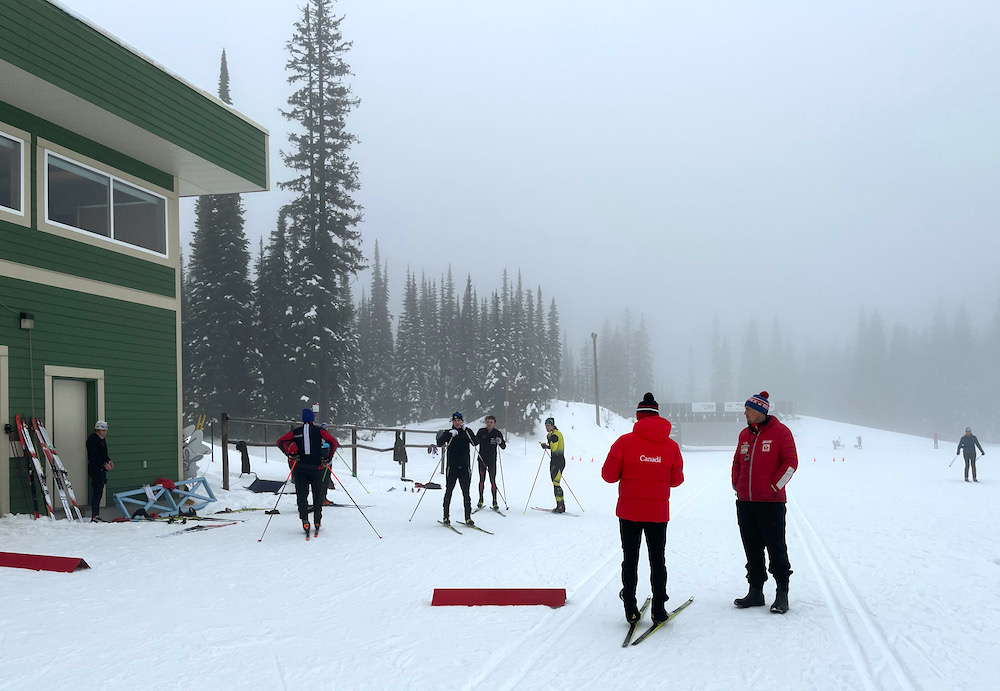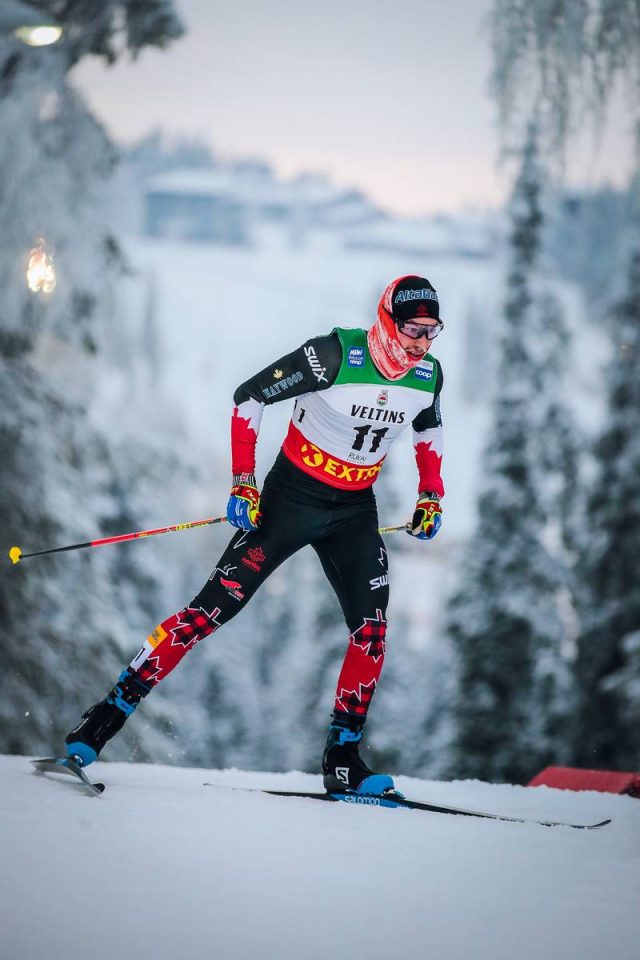
Last season, Canada held no races, posted no domestic results, and, in general, vanished into the pandemic fog.
Travel restrictions meant that many Canadian skiers didn’t see any skiers from other regions.
Which skiers made progress and which regressed over the last 20 months? We finally have hints after the first races last weekend. What is new? Lots. What happens next? Keep reading.
Athlete Progress
Following the opening FIS races, part of the Western Canada Cup series, which happened December 4th and 5th at Sovereign Lake in Vernon, BC, Nordiq Canada and its followers finally had results that could be used to assess athlete progress.
Many athletes from Québec, Ontario, Manitoba, Alberta, and BC spent time at Sovereign Lake in November, getting a combination of elevation and snow. Most were confident in their preparation based on summer training with teammates, including the few athletes who race the World Cups last season or were in Europe in November. However, the coaches were still likely to shrug when asked who was fast this year.
FasterSkier’s research suggests that Sam Hendry was the Canadian with the most races last year. A student athlete at University of Utah, he was able to travel and compete on both the SuperTour and NCAA circuits. The small group of athletes who raced World Cups and U23/U20 Championships in February and March had no warmup races before racing at the top level and ended the season with less race days than Hendry.
FasterSkier will be sharing more in-depth athletes profiles in the coming weeks.
Calendar Changes
Canada has dropped the NorAm name, a leftover from the depths of history when the US and Canadian series merged into one North American series. Since the SuperTour split off some years back, the reversion to the Canada Cup name (as in a Continental Cup race held in Canada) is appropriate, even overdue. A name change, however, is simply symbolic. Real change requires action, and action usually results in anger from the people who were demanding change.
As originally planned for last season, the series is now divided into Western and Eastern, which is expected to reduce travel costs and make it easier for skiers to stay in the sport until they are ready to earn a permanent place on the World Cup team. The obvious downside is that the top skiers won’t meet until national team and Olympic trials in Canmore. FasterSkier has been talking to skiers about pros and cons and will follow this shift closely.
Building a season schedule in Canada doesn’t get much easier with the east/west division. The country spans 5.5 time zones and the geographically larger west division has a much smaller population. Every possible calendar and scenario includes lots of travel.
Olympic trials need to be held at elevation as Beijing is at 1,800m, and the west has the only three homologated courses above 1,200m (Canmore, Rossland, Sovereign Lake). Ideally, there would have been early trials on snow for the World Cup period 1 starts, but that would also have to be in the west because the east doesn’t have appropriate courses available in October/November. With 2022 Nationals scheduled for Whistler, the obvious solution would be to have all major events in the west. This would (reasonably) be seen as unfair to eastern athletes. The ‘least bad’ answer was not to have trials in October.
The divided schedule has Sovereign Lake December 4th-5th followed by Rossland, also in BC, on the 11th-12th. In the east, Nakkertok, just north of Ottawa, will host races on the 11th-12th, followed by Mont Sainte Anne, further east in Quebec, on December 18th-19th. Everyone comes together for the first time at the trials in Canmore January 6th-11th. These competitions will be used for athlete selection for the Beijing Olympics, U23/U20 World Championships, and World Cup period 4, which means pressure to perform for everyone.
Nordiq Canada Changes
NC has made a tonne of staff changes since last season. There is now a NextGen coach to bring skiers up to the top level, and a Development Coach to deliver skiers to the NextGen coach. Chris Jeffries, longtime leader of the Alberta World Cup Academy, has been named High Performance Director. Julie Beaulieu is working on the development side. Nathaniel Mah has retired from Nordic Combined competition and is Marketing Engagement Coordinator. Ilona Gyapay has had a role shift, described by one deeply-connected race official as ‘the new Dave Dyer’. (Dyer spent many years with Nordiq Canada, before ending his career as Events Director.)
Erik Bråten was originally hired in the fall of 2018 as a NextGen coach with a secondary focus on developing the base of the pyramid before having his role changed almost immediately to the “Everything Coach”. After two and a half seasons, he left NC in April, 2021. He later rejoined as a World Cup coach for the 21/22 season.
Eric de Nys was selected as NextGen coach in June. He started work in August, joining in at the Penticton national team camp organized by Dave Wood, which had been moved to Vancouver Island to escape wildfire smoke.
De Nys organized the traditional Canadian elevation camp in Mammoth, California. For BC athletes this was out of the smoke and into less smoke, as California was also burning. This camp is important for Canada because it allows a range of elevations that aren’t practical in BC or Alberta and don’t exist in the rest of Canada.
“BC has good elevation, but in an Olympic year, good enough won’t be good enough.” — Wood, July 2021.
Matt Smider was hired as Development Coach in time for Canmore’s Frozen Thunder team camp in October, once again led by de Nys. Smider is known for sparking the growth of small town Revelstoke Nordic into the big leagues; these skills will be useful to fill the development pipeline.
De Nys lead a mix of NextGen and World Cup athletes to Muonio and Gällivare to race continental cups, with promising results against the top skiers from Finland, Russia, Italy, and Sweden. At this point, the casual observer might think that the NextGen coach role was blurring to fill the gap created by the absence of a national team head coach.
Future

Racing season is here and most eyes will be focussed on the next race. Some Canadians began their seasons in Europe. Rémi Drolet and Russell Kennedy knocked out good results in Finland and Sweden. McKeever easily won all three junior races in Gällivare against a stacked Swedish field. In the first World Cup weekend in Ruka, Antoine (Toni) Cyr led the way with an 11th in the classic 15km and 12th in the free pursuit. First year senior Olivier Léveille moved up to 17th in the pursuit while Russell Kennedy, Katherine Stewart-Jones and Cendrine Browne all earned World Cup points.
Jeffries will join full-time in April, the delay allowing him to make sure his current Alberta World Cup Academy athletes don’t have their Beijing preparations interrupted. He was clear that adding a head coach is a priority for next season.
This writer had two full seasons without seeing any of the athletes race in person, which leaves me feeling blind. The last FIS points race I watched in person was the 2019 WC finals in Québec City. It is hard to go into a new season without a good guess of which athletes to watch, but that challenge is shared by the athletes themselves.
Canadian racers missed two years of nationals and an entire season. For an athlete having a breakthrough year, nationals is where they get to show that improvement. Nationals is also the one chance for domestic racers to test themselves directly against the WC team.
“For an 18 year old to miss a year and really two years when 2020 Nationals were cancelled, is a huge amount of time,” de Nys said. “For a first year U20 aged athlete, they will have missed racing a Nationals and an entire calendar year as a U20 with another Nationals completely. In essence, they will go from a Junior to a Senior with no race experience to help them navigate that landscape.”
With some Canadian skiers doing well in Europe and others waiting to test their progress, it is fair to ask how Nordiq Canada will help them succeed. It is common to hear people in the sport use phrases like ‘those people in Canmore’ or refer to Nordiq Canada as an opaque office that is not connected to the clubs and provinces.
“A lot of our resources and core operations still get based out of Canmore. So an athlete that lives in Quebec on the National Ski Team still probably feels as though they’re not as engaged in the National Ski Team as an athlete skiing in Canmore, [and] we need to change that,” Jeffries told FasterSkier. “But it’s already changing.”
Jeffries went on to point out that CEO Stéphane Barrette, HP Manager Joel Jaques, de Nys, Smider, and Jeffries himself do not live in Canmore.
“One of our number one objectives for the first two years of this next quad is to make inroads on breaking down that perception of those barriers.”
Watch this space for more detail on NC direction as FasterSkier was able to catch up with Barrette, Jeffries, de Nys, and Smider on the snow at Western Canada Cup #1.



